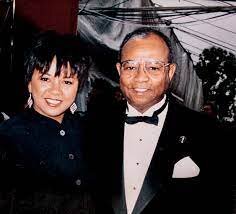The Brilliance of Ashley Boone Jr.
Courtesy Ted Williams, Iconic Images, Fair use image
written by Jacob Nadir
It’s always an interesting equation when Black History intertwines with American capitalism. The American entertainment industry in countless instances has both been violent as well as embracing towards Black people. The scale leans towards violence, yet the instances of Black makers and creators existing and excelling within the industry still serves as a history worth knowing. Like most Black history, the Black journey in Hollywood follows a pattern of entering a new world with unimaginable assets, putting these assets to use within the parameters of this new world, these assets get used to extinction or stolen, a Black person is erased from history, but Black history remembers them still.
The life and career of Ashley Boone Jr. is a great entry point into this pattern. There’s been more attention on him lately since a Hollywood Reporter piece was written on him in February of 2020, but up until his passing in 1994, Boone’s career was a consistent exhibition of knowing his worth as well as applying his intimate understanding of movie-going audiences. He had received limited press during his life, but his achievements speak for themselves. The success he represents serves as a blueprint for one of the ways that someone can navigate the treacherous Hollywood landscape that, in many ways, has been stuck in time.
Boone (right) with his sister Cheryl Boone Isaacs.
Anyone familiar with the name of Ashley Boone Jr., typically thinks of one or two things. One being the role he played in bringing Star Wars to the masses. The other being his sister Cheryl Boone Isaacs who is a trailblazing publicity and marketing director, helping promote movies such as Close Encounters of the Third Kind and Once Upon a Time in America. Then as Executive Vice President of Worldwide Publicity for Paramount, she created campaigns for Forrest Gump and Braveheart, which both won Best Picture Oscars. eventually working at New Line Cinema in 1997 she moved up to be the first Black woman to head any studio marketing department. Boone Isaacs then became the first Black President of the Academy of Motion Picture Arts and Sciences in 2013. For both Ashley and Cheryl, the marvel isn’t as much in the achievements but more so in the “how”.
Perhaps being a President of Marketing and Distribution is a thankless job no matter who you are, but to be the first Black person to hold that title and for the first title under your belt to be Star Wars, you’d think Ashley Boone Jr.’s story would be a little more widely known. Since 1972 when Fox had no idea what to do with Sounder, a film written by Lonne Elder III and directed by Martin Ritt, Boone Jr. (head of marketing at Fox at the time) took the film on himself to promote up until it received a Best Picture nomination at the Oscars. He started out by showing the film to schoolchildren across the country. A creative approach that would manifest in different ways throughout his career. Including “saturation booking” for Dirty Mary, Crazy Larry in 1974. Placing the movie in an abundance of theaters worked and the film was Fox’s biggest hit of the year. A year later, Jaws would be the next film to implement the distribution strategy. Through midnight screenings, Boone Jr. helped to make Rocky Horror Picture Show a cult hit. Sneak previews arranged by Boone Jr. helped make The Omen and Silver Streak into Blockbusters. Each film presented a unique opportunity for different distribution strategies.
In 1976, for the first time, Fox merged marketing and distribution into one department with Boone Jr. at the helm. There he continued with another creative approach to a film that Fox wasn’t too enthusiastic about. Despite this looming tone from the studio, Boone Jr. and a few other executives viewed this film at a small screening near San Francisco and knew it could be a hit. That film was Star Wars. Boone Jr. and George Lucas pushed for the film to be opened just ahead of the final days of the school year so kids could see it and spread the word. Well, word spread, and Star Wars became the highest-grossing film of all time.
Still, a change in the regime at Fox led to Boone Jr. being treated as disposable. He was essentially demoted so he left and started his own consulting firm. His first project was The Empire Strikes Back. He did the campaign for Chariots of Fire which won the 1982 Best Picture Oscar. Then in 1983, with Columbia, he helped bring Ghostbusters to blockbuster status. He rounded out his career as a ubiquitous figure in the entertainment industry. He was on the advisory committee for the U.S. Film Festival which would later on become Sundance. He was elected to the Academy’s board of governors alongside his sister Cheryl. He advocated that SAG divest from South Africa during the height of apartheid. And still, he served as head of marketing and distribution of Pathé/MGM where he helped bring Thelma & Louise to theaters.
This is a career worth talking about because the accolades speak to Boone Jr.’s fluidity - an often ignored quality that is just as essential to navigating the entertainment industry as money or talent, if not more. A good amount of distribution methods originated from a Black man’s adaptability - a man just trying to do his best despite circumstances that made him feel unwelcome. This random intersection of Black history and capitalism is just one of the various pieces I’ll be sharing with you all here at Wavelengths.


